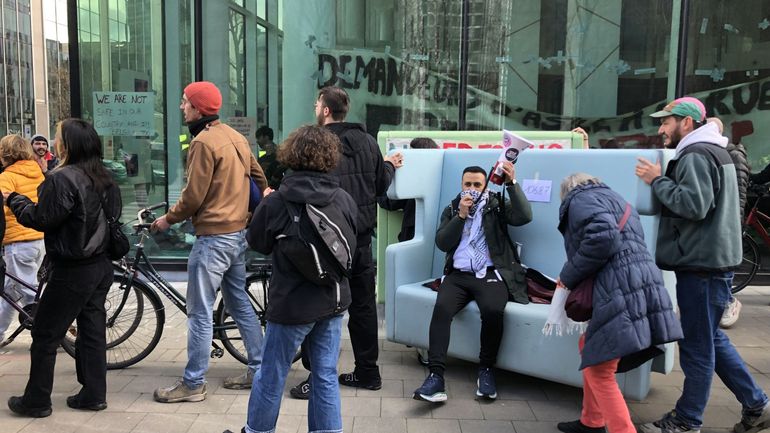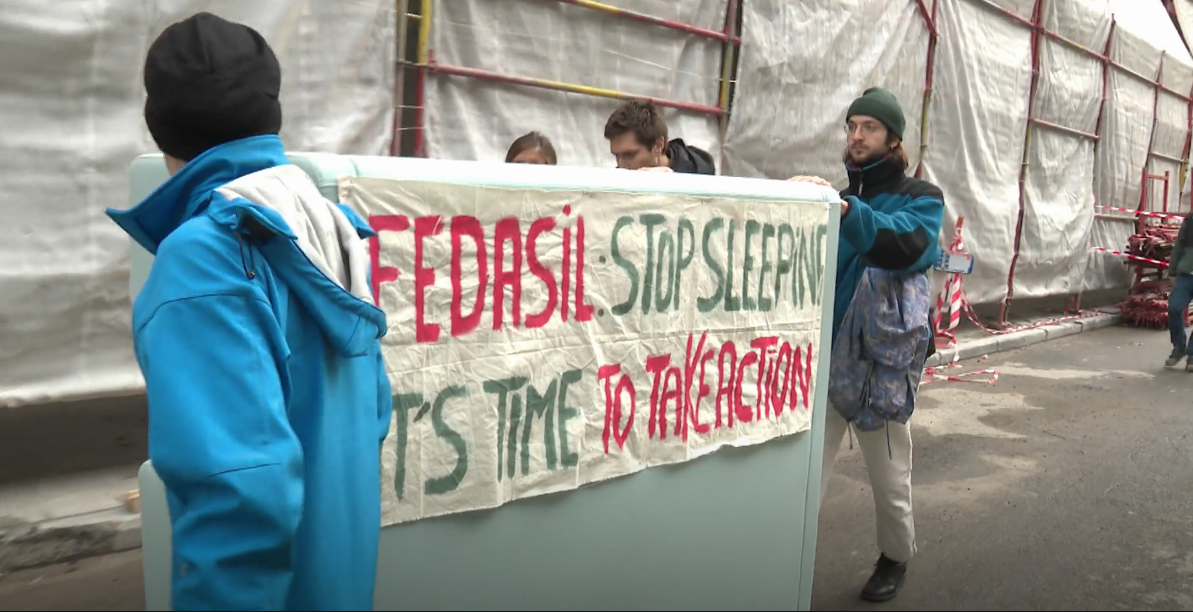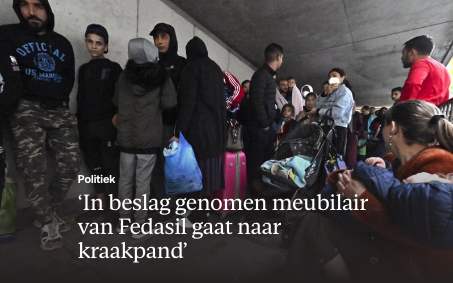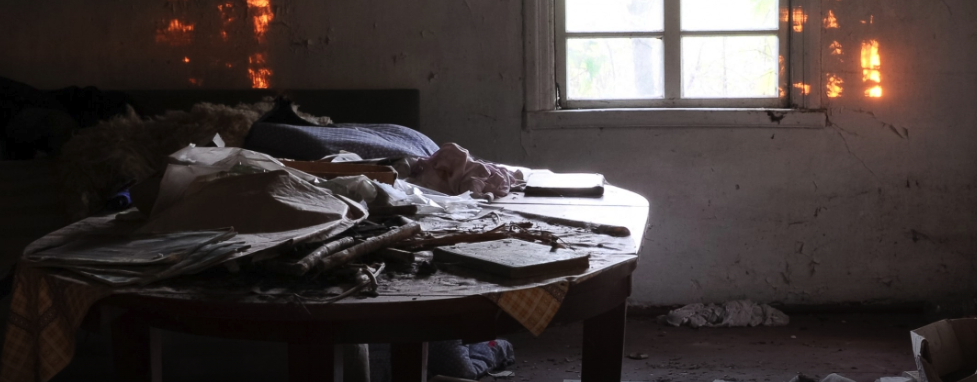
Geveilde meubels Fedasil in kraakpand Brussel: “Schaamte voorbij”
Published March 18, 2023 on Vlaamsbelang

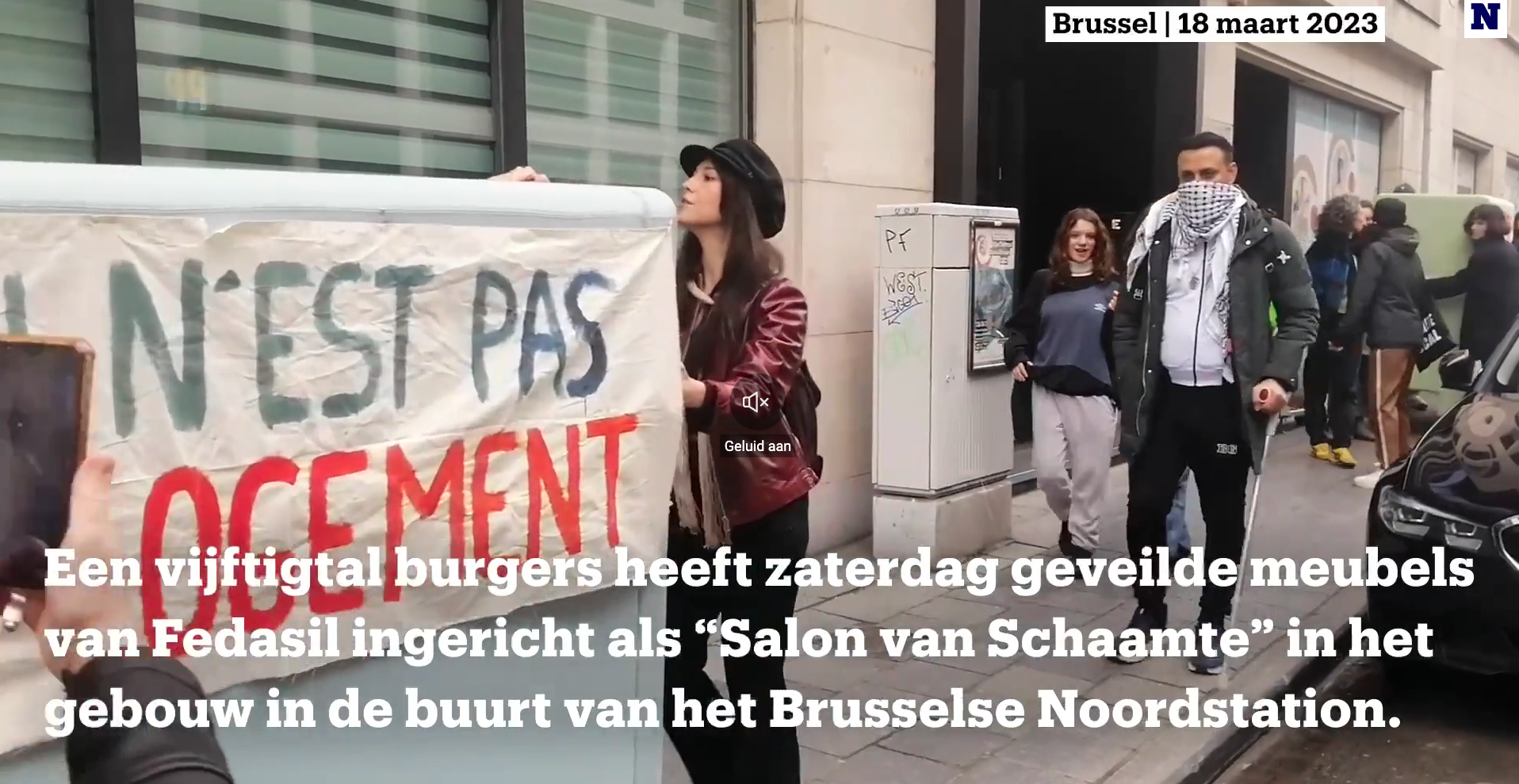
Burgers leveren meubelen van Fedasil af bij asielzoekers voor “Salon van Schaamte”, De Moor betreurt actie
Published March 18, 2023 on Nieuwsblad

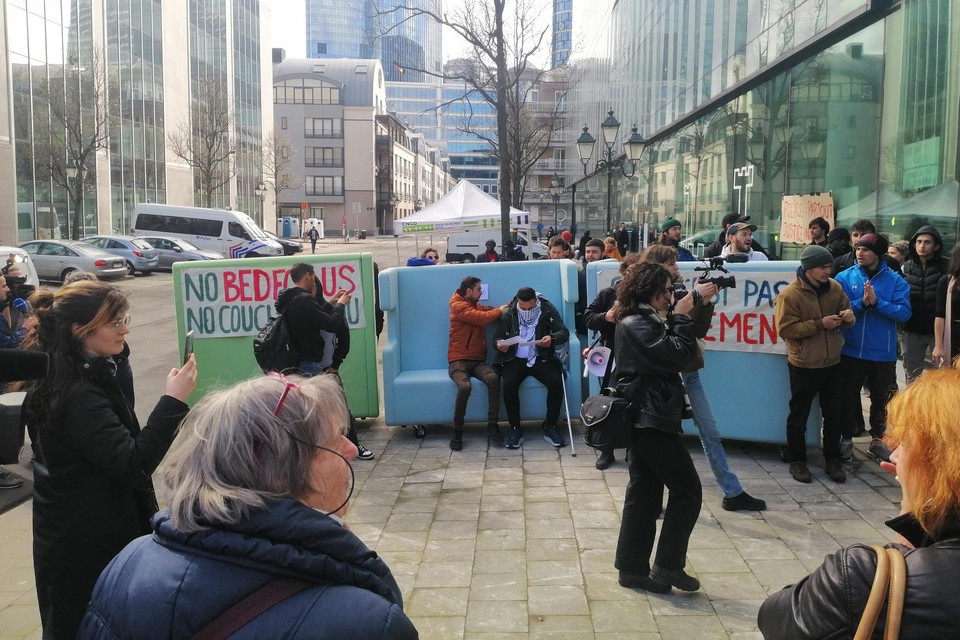
Burgers maken ‘salon van schaamte’ met meubelen van Fedasil, De Moor betreurt actie
Published March 18, 2023 on De Standaard

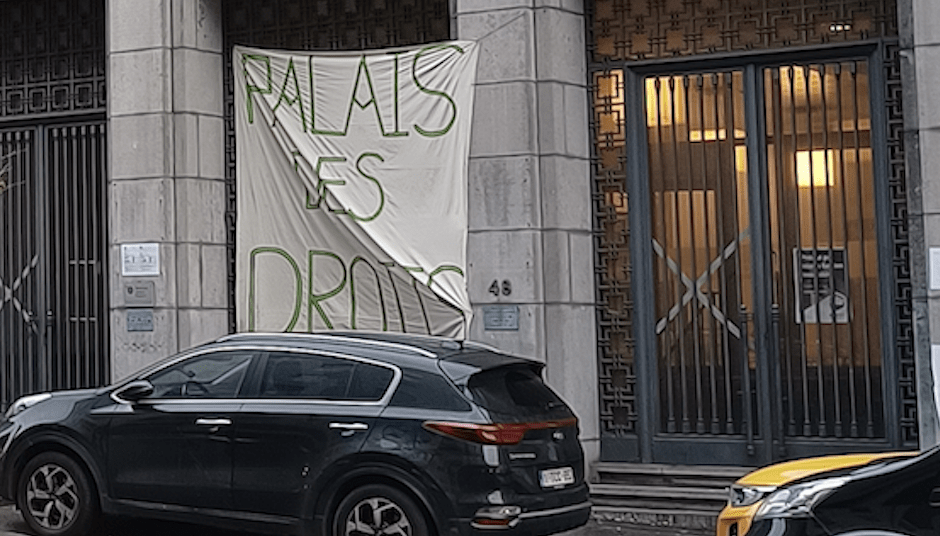
Palais des Droits: A squat with a future

Published Saturday March 4th, 2023 13:18, De Wereld Morgen
Op. Ed – Viviana d’Auria, Luce Beeckmans, Tasneem Nagi, Heleen Verheyden, Céline Drieskens, Aikaterini Anastasiou, Jeroen Stevens, Isabelle Beno, Dounia Salamé .
A group of academics at KU Leuven’s Department of Architecture is reacting to the inappropriate manner in which the ‘Palace des Droits’ was cleared on 14 and 15 February in Brussels’ Rue des Palais. They argue that there is an alternative on site: “The Palace could be a pilot project for a city like Brussels that wants to burn itself as a liveable and tolerant city.”
Texte français ici. Nederlandse tekst hier.
On February 14th and 15th 2023, the Palais des Droits, a former office building in Brussels, was chaotically evacuated. For more than four months the building accommodated a heterogeneous community that shared a common demand for dignified housing in the city.
By promising to provide shelter to all residents after eviction, the Brussels Region seemed to break away from a longstanding tradition of treating people according to their legal status and responsible government agency rather than according to their (housing) needs.
Two weeks later, it has nevertheless become clear that a considerable amount of residents from the Palais des Droits never received housing. Instead, the problem of accommodation was simply relocated to other places in Brussels, including the bridge in front of the registration center in the Petit-Château/ Klein-Kasteeltje (where people were in fact already staying prior to the occupation of the Palace, but they were not picked up by buses, demonstrating both the opportunism and the total arbitrariness of the reception policy).
Moreover, some people who resided in the Palais were never eligible for shelter (such as rejected asylum seekers or those falling under the Dublin Protocol) and with the eviction they risk falling through the cracks of bureaucracy yet again.
For them, this is likely to be another episode of exclusion, one exacerbated by a media storm tainting the Palace’s ‘squatters’ to crime, illness and drugs. Yet, what characterized this community is first and foremost the fact that their right to housing was violated and that they had found a temporary refuge in the Palais to escape homelessness.
The Palais is located along the royal “tracé” that connects the Palace of Justice and the Rue Royale with the Rue des Palais. This urban axis not only hosts major vacant public buildings, but also displays past and ongoing struggles for the right to housing.
Four of the most iconic occupations of vacant buildings of the last two decades are situated along this line: the ‘123’, the Gesù Church, the occupation on rue Royale 312 and the Palais being the latest under eviction.
Ironically, the Palais stands spatially and symbolically against the idea of justice. The occupations make visible the intersection between the housing and hospitality crises in Brussels, as well as the inevitable deadlock we end up in as asylum and migration on the one hand and housing on the other are settled at different administrative levels.
While Secretary for Asylum and Migration De Moor stresses the importance of structural reforms for stronger borders, quicker procedures and an improved return policy[1], we argue that structural reforms are needed that address the causes that create both vacancy and homelessness. To this end, policies should be implemented across fragmented policy responsibilities and preferably at the city level.
Affiliated with the Department of Architecture (KU Leuven) and with the Palace as a neighbor of one of our campuses, we believe that architects can play an important role in imagining a new urban project of hospitality and justice. This imagination is currently completely lacking.
Even a vacant public building like the Palace, owned by a social housing company, could not generate the imagination in the relevant authorities to use vacancy as an opportunity to address the growing homelessness and to do so independently of people’s legal status and across fragmented powers. The building was (forcibly) vacated even though it provides the beds that Fedasil is still lacking and the roof over the head that the many homeless people in Brussels have yet to find.
However, the Ukrainian crisis has shown that innovative solutions to asylum reception are possible. Nevertheless, these solutions are selective in their target population and, as Boie and De Cauter noted earlier, even the innovative mobilization of housing actors in the case of Ukrainian asylum seekers is not structural but short-lived.
Temporary occupations such as the Palais, represent an obvious, albeit imperfect, answer for designing a more hospitable urban future. They also reveal the major gaps in the (political) architecture of housing, care and shelter.
Although the powers of the state are fragmented in a country like Belgium, empty (public) buildings in Brussels offer the best opportunities to create an “architecture of the state” based on hospitality rather than hostility. This can build on the many efforts of NGOs, civil society organizations and citizens instead of tearing them down.
As architects, we argue that it is time to create a permanent infrastructure for what are erroneously viewed as ‘temporary’ crises. For the time being, critical and spatial thinking in permanent and sustainable terms does not seem to exist when we witness how Fedasil builds and destroys its capacity every few years or when we find that the Humanitarian Hub in Brussels will have to move again.
In the case of the Palace, the Brussels Region may have managed, in a chaotic but relatively peaceful manner, to dismantle an explosive situation of which the biggest fear was that it might explode in its face. What is not yet in sight, however, is the birth of a long-term plan that deals sustainably and structurally with resources to (temporarily) accommodate the most vulnerable urbanites based on their socio-spatial needs rather than their legal status is.
If we are to take design and architecture as a site of “restorative justice” seriously – which we practice in numerous research and education projects within the university – the Palais would be an ideal setting to start experimenting with innovative forms of housing, based on hybrid housing coalitions and innovative space-sharing. These would build on the work of recognized organizations with deep ties to relevant communities which would allow them to include the communities concerned in all stages of the design process.
The Palace could be a pilot project for a city like Brussels that wants to show itself as a liveable and hospitable city. With some imagination, this could allow for longer-term development of inclusive urban infrastructures, catering to people with and without citizenship, and allowing for a much needed continuity of housing trajectories.
Do we want to see it happen?
Signed by following members of the Department of Architecture at KU Leuven (Faculty of Architecture + Faculty of Engineering):
Prof. Viviana d’Auria, Prof. Luce Beeckmans, Tasneem Nagi, Heleen Verheyden, Céline Drieskens, Aikaterini Anastasiou, Jeroen Stevens, Isabelle Benoit, Prof. Em. Frank Moulaert, Stijn Cools, Joris Moonen, Geert De Neuter, Prof. Karel Vandenhende, Layla Zibar, Stefan Boeykens, Cato Leuraers, Ward Verbakel, Prof. Lucía C. Pérez Moreno, Prof. Krista De Jonge, Jakob D’herde, Prof. Thomas Coomans, Prof. Bruno De Meulder, Prof. Hilde Heynen, Wei Lei, Prof. Kelly Shannon, Jona Moereels, Dounia Salamé, Prof. Em. Koen(raad) Van Balen, Daan Van Cauteren, José Fernando Higuera Osorio, Changxue Shu, Yasmin Zainul Mochtar, Prof. Pieter Van den Broeck, Sarah Flebus, Prof. Guido Geenen, Els Van Meerbeek, Jan Lim, Jan Bleyen, Maxime Prananto, Piet Tutenel, Ruth Segers, Julie Claeys, Xenia Katsigianni, Prof. Yves Schoonjans, Khalda El Jack, Inge Claessens, Natasja Ausseloos, Jana Peeters, Karina Desmet, Isabelle Van den Bossche, Sandra Pierpont, Yuri Gerrits, Katrien Vandendorpe, Michelle Mlati, Constance Uyttebrouck, Jan van Hoof, Sandro Armanda, Gitte Schreurs, Martine Demaeseneer, Jasmien Wouters, Koenraad Danneels, Janno Martens, Liselotte Vroman, Rosaura Hernandez Romero, Tristan Claus, Bruno Meeus, Björn Bracke, Marie Vanderghote, Maxime Vancoillie, Kristien Van Crombrugge, Wouter Krokaert, Xavier Mendez Abad, Helen Van de Vloet, Annemie Demeulemeester, Prof. Koen De Wandeler, Lars Fischer, Prof. Filip Mattens, Jolein Bergers, Ellen Verbiest, Prof. Sven Sterken, Dries Pattyn, Teodora Stefanova, Prof. Bruno Notteboom, Prof. Rajesh Heynickx, Olga Peek, Siel Vandamme, Kezia Eka Sari Dewi, Tom Thys, Claire Bosmans, Leen Scholiers, Nathalie Vackier, Evita Piscador, Javier Rodriguez Soriano, Prof. Anne-Françoise Morel, Gudrun De Maeyer, Alice Payne, Hülya Ertas, Prof. Lieven De Cauter, Gideon Boie, Jesse Honsa, Nele Stragier, Doug Allard, Stijn Paredis, Arian Schelstraete.

‘We are like children here’: The ‘crossroads’ of legal and moral aspects of indeterminacy
Footnotes
[1] The Emergency Support to Integration and Accommodation (ESTIA), was initially implemented by UNHCR in collaboration with the local authorities and NGOs and funded by the European Union Civil Protection and Humanitarian Aid (ECHO). The project provides temporary accommodation for relocation candidate and vulnerable asylum seekers through rental apartments in various parts of Greece. The second phase of the program is being implemented by the Ministry of Migration and Asylum in an effort of centralization of the immigration policy.
[2] United Nations High Commissioner for Refugees
by Aimilia Voulvouli | University of Thessaly
It is early in the morning in the inter-cultural centre Stavrodromi in Karditsa, Greece, and employees as well as beneficiaries, that is, international protection seekers are frustrated. Stavrodromi, which can be translated as “Crossroads”, is a pilot infrastructure created through the “Emergency Support to Integration and Accommodation” – ESTIA[1] program. It is located in the heart of the city, at the Municipal Market which is a bazaar styled structure that hosts public and private businesses as well as a social grocery store, a bar, a small museum, the Red Cross branch of Karditsa, a radio station, a local newspaper, cultural associations and it is generally considered a meeting point by the locals.
Stavrodromi has been founded by the Development Agency of Karditsa (its Greek acronym reads as ANKA) and hosts all the social services of ESTIA. Eventually, it became a point of reference for the beneficiaries. There, they can get social services aimed at them or information on other services they need. It also runs a language school for Greek, Arabic and French. Computer spaces are also available for the beneficiaries to use, as well as a space for women and their children to spend their time creatively.
In May 2022 the last installment of the funding of 2021 has not yet been allocated to implementing bodies such as ANKA. Without these installments, rent and utilities are going to be overdue for the rental apartments that are used by the ESTIA program. A few months ago, the cash assistance program which was initially implemented by UNHCR[2] was taken over by the Greek authorities which also resulted in delays in payment. For about six months now, both employees and beneficiaries find themselves in an indeterminate situation. Employees don’t know when they are going to get paid for the services they have signed a contract to provide, and whether these contracts are going to be renewed. The beneficiaries don’t know when they are going to get their cash assistance or whether their shelters are going to be secure.
“We had to change apartment and live with two more families and now we are told that this might happen again due to financial difficulties. We are like children here who are told what to do. There is no stability”, said Tarik, one of the beneficiaries, during our interview earlier that week in May 2022. Similarly, John said during an informal discussion while he was visiting Stavrodromi to meet up with a potential employer: “My asylum interview is in May 2023, in the meantime I wake up in the morning and I don’t know what’s next. Am I going to have the same apartment? Am I going to be able to find a more steady job? I am now working here and there whenever there is a need for hands from the employers that ANKA is in liaison with. I feel like a child whose everyday life gets dictated by my parents and I have to improvise and be creative the whole time”. On the other end, Maria a psychologist working for ESTIA told me that she has already started looking for a new job because she understands that the stability that she had until now is not going to last long. In an informal discussion I had with the CEO of ANKA back in December, he told me that while they are legally not obliged to continue offering their services since they have not received the agreed amount, they feel morally obliged to do so, for the beneficiaries, the employees and the owners of the apartments they rent. “But for how long?” he said. I asked him how they are going to deal with the lack of funds in the meantime and he replied that he and his colleagues are trying to find ways which are not exactly official at the risk of having themselves held accountable by the home owners, the suppliers of food and other basic necessities and other employees of ESTIA.
Heath Cabot (2013:453), writes that the indeterminate effects of “aid encounters in the context of asylum procedures may give rise to a circumscribed agency” that attempts to overcome structural hindrances and institutional gaps. Is it through this agency, within the ‘capitalist cracks’, of people acting ‘in-and-against the system’ that arrival situations are being created, transformed and appropriated in Karditsa? How can/should beneficiaries position themselves in such a process? Which are the legal indeterminacies and how creative can moral praxis become?
Our fieldwork thus, revolves around the formal but mainly the informal infrastructures that are created through crossroads and despite off the structural hindrances of ESTIA.
Sources cited:
Cabot, H. 2013 “The social aesthetics of eligibility: NGO aid and indeterminacy in the Greek asylum process”. American Ethnologist 40(3): 452-466.
Holloway, J. 2010 Crack Capitalism. London: Pluto Press
Suggested reading:
Marry-Anne, Karlsen, M. Jacobsen Christine, and Khosravi Shahram. 2020. Waiting and the Temporalities of Irregular Migration: Taylor and Francis. With a chapter on Greece by Katerina Rozakou.
Share

Refugee families being moved from London to Leeds – our research shows what is lost when newcomers have to leave a neighbourhood
Published February 17, 2023 on the Conversation, written by Tamlyn Monson and Malte Gembus
Refugee families being moved from London to Leeds – our research shows what is lost when newcomers have to leave a neighbourhood
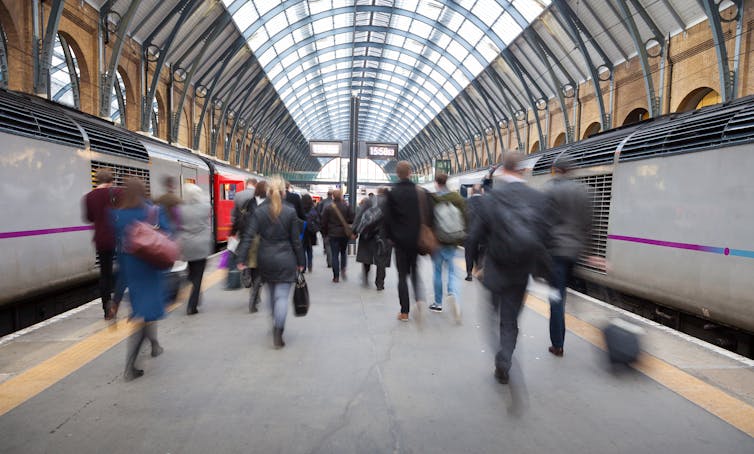
Just over a year after fleeing the Taliban and seeking asylum in the UK, more than 150 Afghan refugees, including children, are facing more upheaval. In a matter of weeks, the Home Office has given dozens of refugee and asylum seeker families short notice that they will be moved from their accommodation in London to hotels in Yorkshire and Bedfordshire, hundreds of miles away.
Many new arrivals find themselves moved to different areas, often where accommodation is cheaper. This involves taking (often vulnerable) people far away from the neighbourhood where they have begun settling in, and where they have started in local schools and jobs. Our research in the London boroughs of Newham and Barking & Dagenham illustrates how important these point-of-arrival communities are to refugees – and what is at stake when people are made to leave.
Our work involves speaking to newcomers, learning about their experiences since arrival, spending time in local places that feature in their lives, and working alongside people that provide services and support.
The resources, opportunities and support structures people use to get orientated in a new community make up what we call “arrival infrastructure”. This involves interactions with people, from paid service providers to friends, colleagues and strangers on the street. It happens in parks, markets, barbershops, libraries, community centres, schools and shared accommodation.
New migrants invest a lot of labour and energy in becoming accustomed to new surroundings, getting to know a new neighbourhood, working out how to access local services, schools and GPs, and building relationships in the community. Even more emotional and physical effort is needed to secure a job. For many, this depends on establishing relationships with the right people first.
Changing places
Schools, community centres, and places of worship; friends, co-tenants and colleagues; even the local off-licence – all of these are key parts of arrival infrastructure. They can’t be packed up and moved to a different locality.
The decline in affordable housing and council accommodation in the UK has created dilemmas for local councils and the Home Office when it comes to housing vulnerable residents. Yet authorities need to weigh the financial gains of moving families against the losses to vulnerable people who are forced to abandon the lives they have built and go somewhere else.
A Home Office spokesperson told The Conversation: “While hotels do not provide a long-term solution, they do offer safe, secure and clean accommodation. We will continue to bring down the number of people in bridging hotels, moving people into more sustainable accommodation as quickly as possible.
"Occasionally families may be moved from a hotel scheduled for closure to another hotel. In these instances, families are given appropriate notice of a move and are supported by their local authority every step of the way.”
We know from our research that access to support varies from place to place. One ex-asylum seeker we spoke to easily accessed a GP in her Dagenham neighbourhood. But she struggled to get healthcare in other areas, where local surgeries insisted on proof of address that she was unable to provide while in Home Office accommodation. Although NHS policy does not require documentary proof of address, some surgeries insist on it. Healthwatch has found this to be a common barrier preventing people from registering with a GP.
We also know that schools and workplaces can be crucial in settling in – and not purely because they offer an education or a salary. Among new arrivals in Barking, work often provides opportunities for friendships, knowledge-sharing and improving English language skills.
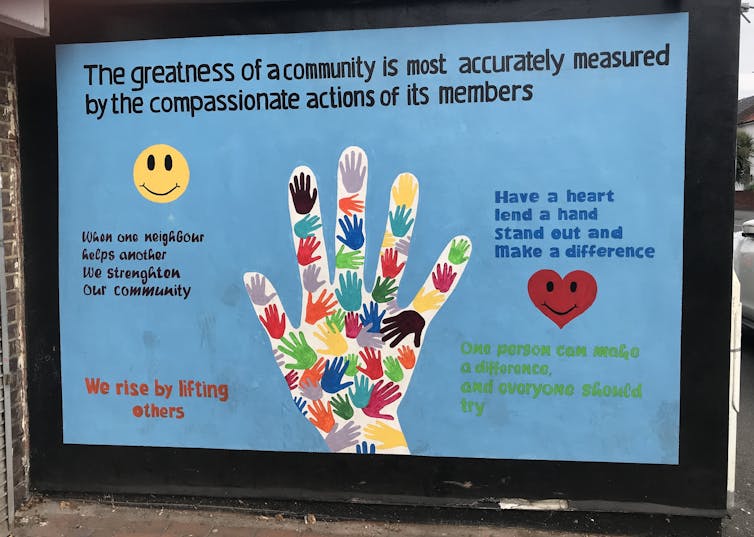
Schools as arrival hubs
Our research shows how important schools are in helping newly arrived families settle in. Some schools become real “arrival hubs” in their local area where staff fulfil a variety of roles going way beyond education. They help newly arrived families navigate complex bureaucratic processes and make social connections in the neighbourhood. Perhaps most importantly, they provide emotional support in times that can be uncertain and distressing.
As Soofia Amin, assistant head teacher at Kensington Primary School in East Ham, told us:
We strive to be there as a constant support with our doors always open, this is what helps our newly arrived families. We are the safe space when they first arrive.
One woman we spoke to, Daniela (not her real name), is a mother and volunteer at a primary school in the London borough of Newham. After several years in the borough, Daniela now feels confident about how to find help and participate in local life.
Now I can say that with any problem I have, I know where to go. Maybe it’s because I have been here for longer and I grow a little bit to understand where to go in the neighbourhood. And really, we have a lot of support here. Anything you need – you can go to school; you can do anything.
Daniela and Soofia remind us of the value of a neighbourhood in helping new arrivals solve problems, access services and get involved in local life. In this sense, the costs for refugees being moved away from their jobs and schools goes deeper than the obvious impacts to their education and income. Their wellbeing, social inclusion, participation and sense of belonging are all at risk.![]()
Malte Gembus, Postdoctoral research fellow, Coventry University and Tamlyn Monson, Postdoctoral research fellow, Coventry University
This article is republished from The Conversation under a Creative Commons license. Read the original article.

